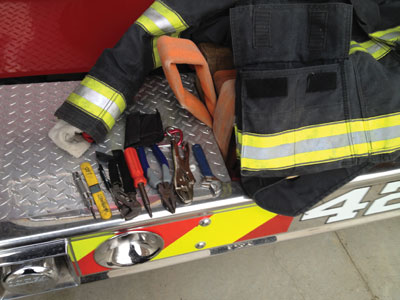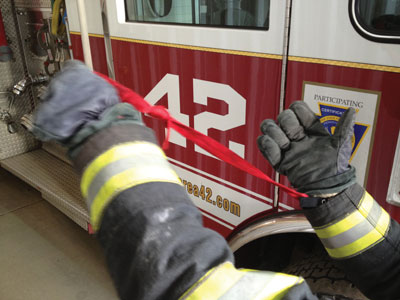
Tim-Bits: April 2012
Tim Llewellyn
Features Structural TrainingMany recent fire-service blog posts and web pages have focused on what we carry in the pockets or hang on the hooks of our turnout gear.
Many recent fire-service blog posts and web pages have focused on what we carry in the pockets or hang on the hooks of our turnout gear. The posts offer long lists of items, some good suggestions and some not so good. It sometimes seems that each contributor is trying to one-up the previous with a more elaborate list. The take-home message is easy – firefighters should carry a few essential tools in their pockets. Let’s discuss not what we carry, but where we carry our tools.
I have found that carrying tools in the pockets of my turnout coat is much easier than carrying tools in the pockets of my turnout pants. The coat pockets are smaller and tend to keep the tools more organized, and I feel that the coat pockets are much easier to reach into when crawling. Also, I’ve painfully discovered that the tools in my pants pockets tend to sway back and forth when I walk, and they always end up poking my legs.
Years ago, one of my mentors taught me a method for organizing the tools I carry in the pockets of my turnout coat, and it has helped me to bring order to my personal tool cache. This system has really helped me to remember where each tool should be stored. The method is easy – the first step is to divide the tools you carry into two categories: tools for rescuing victims and tools that can be used to save your own life if you become tangled or trapped.
- Tools in the Rescue category are stored in your right-side pocket.
- Tools in the Life-saving category are kept in your left-side pocket.
- Rescue on the right; life on the left.
 |
|
| Tools in the rescue category, which go in your right coat pocket, are: a 6-in-1 screwdriver, a small wrench, modified channel lock pliers, vise grips, an elevator key, a shove knife and a folding spanner wrench. | |
 |
|
| In the right sleeve, keep a piece of webbing with small loops tied into each end, for when you need to extend your reach (right = reach) to haul a tool or lower a hose. Photos by Tim Llewellyn Advertisement
|
Examples of tools in the rescue category are: a 6-in-1 screwdriver, a small wrench, modified channel lock pliers, vise grips, an elevator key, a shove knife and a folding spanner wrench.
Examples of life-saving tools are: wire cutters, medic shears, a utility knife, tin snips, door wedges or other devices designed to keep doors from closing and latching, and a multi-tool.
There should be fewer tools in the left pocket than in the right pocket, because when you face a personal emergency situation, you don’t want to rummage through a crowded pocket with your fire gloves on to find your wire cutters. Keeping just a few items in the left pocket ensures you can get to the tools when you need them. The right pocket can be loaded a little more heavily – but not so much that the volume limits forward or side-bending mobility.
Webbing is often carried by firefighters and it has proven to be a very useful and versatile tool. Storing it can be a bit of a challenge, though. I’ve found that one of the best spots to store webbing is inside the removable kneepads of my turnout pants. The webbing is held in a compact bundle and can be pulled out easily by grabbing a small tag or loop of webbing that hangs out over the top of the kneepad.
When my department changed turnout gear manufacturers, the kneepad option was no longer available to me. I tried several storage methods, including rolled-up webbing stuffed in a disposable exam glove, but none of the methods worked as well as the kneepad system.
Finally, through trial and error, I stuffed the webbing up the sleeve of my coat – sandwiched between the outer shell and the thermal liner – with a small loop hanging from the palm side of the sleeve. For the past five years, it has worked great – the webbing pulls out easily and tangle-free, and it is always right where I need it.
I follow the L and R method with webbing too. In my left sleeve, I keep a 12-foot piece of webbing tied into a continuous loop to be used as a quick girth hitch for victim removal (left = loop). In the right, I keep a longer piece of webbing with small loops tied into each end, for when I need to extend my reach (right = reach) to haul a tool or lower a hose.
Any method of storing your personal tools that works for you is great, as long as you can remember where they are and you can get to them when you need them. That is, if you are carrying any. So, where is your screwdriver?
Tim Llewellyn is a career firefighter for the Allegheny County Airport Authority in Pittsburgh, Penn. A volunteer firefighter since 1989, he currently serves for the Adams Area Fire District in Pennsylvania. Tim has recently been appointed a suppression-level instrutor for the Pennsylvania State Fire Academy and has taught structural firefighting tactics extensively in Canada and the U.S. E-mail him at llewellyn.fire@gmail.com
Print this page